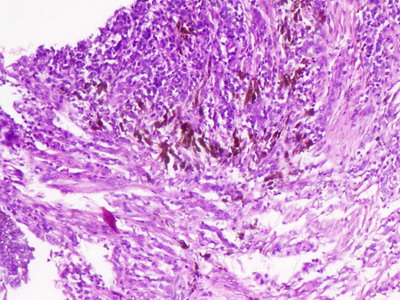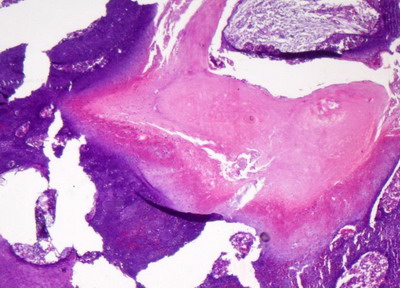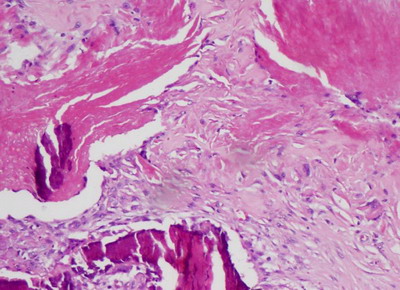|
|
Introduction
Basal cell carcinoma (BCC) may exhibit diverse differentiation. In BCC
with matrical differentiation, islands of shadow cells are located within
the tumor. Shadow cells, characterized by basaloid squamous cells with a
distinct well-defined border and a central unstained area as a shadow of
lost nuclei, are characteristic of pilomatricoma, a distinct neoplasm of
hair matrix differentiation. The presence of shadow cells within tumor islands
composed of follicular germinative cells of an otherwise classic basal cell
carcinoma (BCC) has been considered as a distinct diagnostic category of
BCC with matrical differentiation. A unique variant of basal cell carcinoma
with matrical differentiation. This variant of basal cell carcinoma is extremely
rare with less than 15 case reports being reported in literature. It is
very important to differentiate BCC with matrical differentiation from other
conditions where shadow cells are seen as the clinical management is different.
We report a rare case of basal cell carcinoma with matrical differentiation
in a 68 year old male and review of the literature.
Case Report
A 68- year male patient presented with pigmented growth on the leg which
had been present since 3 months, but started itching and oozing since a
month. On clinical examination, a 2 x 1.5 cms nodular ulcerated pigmented
growth with irregular margins was seen. The lesion was surgically excised
with a clinical diagnosis of squamous cell carcinoma. The H&E-stained sections
of the lesion revealed tumor composed of basaloid follicular germinative
cells (Fig 1).
 | Fig 1:
Photomicrograph showing nests of uniform basaloid follicular
germinative cells, H&E, 200X |
|
In some areas, there was peripheral palisading and stromal retraction
artifact typical of classic BCC. Mitotic figures and apoptotic bodies were
present. Many of the tumor cells were heavily encrusted with melanin in
the cytoplasm (Fig 2).
 | Fig
2: Photomicrograph showing basaloid cells with abundant
intracytoplasmic melanin, H&E, 200X |
|
Elsewhere, the majority of the tumor contained a population of shadow
cells having only ghost outlines of the cells without nuclei, similar to
those seen in pilomatricoma, with basaloid-appearing matrical cells in the
periphery (Fig 3, Fig4). Foci of abrupt keratinisation and calcification
suggestive of follicular differentiation were seen. A diagnosis of pigmented
basal cell carcinoma with matrical differentiation was made.


| Fig 3,4: Photomicrograph
showing islands of shadow cells, with foci of calcification
surrounded by basaloid cells (H&E, 200X). |
|
Discussion
Shadow cells, characterized by basaloid squamous cells with a distinct
well-defined border and a central unstained area indicating the shadow of
lost nuclei, are reminiscent of the matrical portion of the hair follicle
and characteristic of pilomatricoma, or its rare malignant counterpart,
pilomatrix carcinoma.[1] However, shadow
cells are non-specific and have been reported in a variety of other conditions,
including the hair shafts of alopecia areata, follicular cysts, benign adnexal
tumors like trichoblastoma, trichoepithelioam, keratoacanthoma, as well
as adnexal carcinomas.[2] The presence of
shadow cells within tumor islands composed of follicular germinative cells
of an otherwise classic basal cell carcinoma (BCC) has been considered as
a distinct diagnostic category of BCC with matrical differentiation.[3,4]
Basal cell carcinoma with matrical differentiation is an extremely rare
variant of BCC. As of 2008, a report of two new patients and review found
only 12 prior cases of BCC showing matrical differentiation had been reported.[3]
The morphological and immunohistochemical features found suggest that
basal cell carcinomas with matrical differentiation belong to a spectrum
of lesions derived from hair follicles in which beta-catenin plays an important
role in the tumor development, differentiation, and behavior.[3]
Matrical basal cell carcinoma should be differentiated histologically
from other tumors, particularly a pilomatricoma and pilomatrix carcinoma.[5]
This distinction can be challenging but is critical as pilomatrix carcinoma
can metastasize and cause considerable morbidity and mortality while BCC
with matrical differentiation behaves no differently than other BCCs.[6]
Absence of prominent nucleoli and only rare mitotic figures argue against
pilomatrical carcinoma in this instance.
Conclusion
BCC with matrical differentiation is a distinct pathologic entity and
a rare subtype of BCC featuring shadow and matrical cells, typically seen
in pilomatricoma, a benign hair matrix neoplasm. These cases often present
a diagnostic challenge due to confusion with pilomatrixoma or pilomatrix
carcinoma.
References
1. Kwittken J. Shadow cell basal cell carcinoma with acantholysis.
Cutis 2002; 69: 57, 63.
2. Zamecnik M, Michal M. Shadow cell differentiation in
tumours of the colon and uterus. Zentralbl Pathol 1995;140: 421.
3. Del Sordo R, Cavaliere A, Sidoni A. Basal cell carcinoma
with matrical differentiation: expression of beta-catenin [corrected] and
osteopontin. Am J Dermatopathol. 2007 5:470-4. Erratum in: Am J Dermatopathol.
2008; 30:317.
4. Ali F, Brown A, Gottwald L, Thomas J. Basal cell carcinoma
with matrical differentiation in a transplant patient: a case report and
review of the literature. J Cutan Pathol. 2005; 32:445-8.
5. Kim SH, Lee MG, Lee KG. Basal cell carcinoma with matrical
differentiation. Yonsei Med J. 2003; 44:523-5.
6. Haskell HD, Haynes HA, McKee PH, et al. Basal cell carcinoma
with matrical differentiation: a case study with analysis of beta-catenin.
J Cutan pathol 2005; 32:245-50.© 2013 Egyptian Dermatology Online Journal
|




